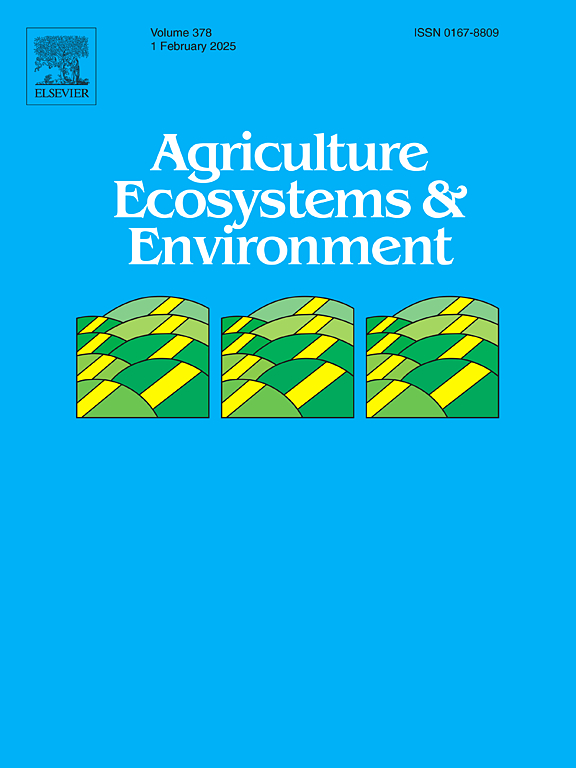Wild bees outperform managed bees in density-dependent pollination for alfalfa reproduction
IF 6.4
1区 农林科学
Q1 AGRICULTURE, MULTIDISCIPLINARY
引用次数: 0
Abstract
Global pollinator declines underscore the urgency of assessing bee pollination, and its impacts on crop yield. Although the independent effects of bee species and density on pollination are acknowledged, their interplay remains understudied, particularly concerning visitation quantity and quality. Using a flight cage experiment, we examined the foraging behaviors of two managed bees (honeybee [Apis mellifera], bumblebee [Bombus lucorum]), and one wild bee (megachilid [Eutricharaea manchuriana]). Additionally, we evaluated their relationships with pollen grains carried, the flower tripping rate, and seed production of alfalfa (Medicago sativa) at five bee density levels (0, 5, 10, 15, and 20 individuals per cage). Bee species significantly differed in foraging behavior and pollination efficiency, with megachilids and bumblebees outperforming honeybees with more visits, flower transitions, pollen carriage, and floret tripping. Honeybee visitation rates increased with density. Bumblebee and megachilid visits peaked at 10 and 15 individuals per cage, respectively. The amount of pollen carried and the rates of floret tripping showed similar trends to bee density. Varied effects on alfalfa seed production were observed based on bee species and density. Higher honeybee density resulted in increased pod production, but bumblebees and megachilids exhibited nonlinear effects, suggesting that there is an optimum (10–15 individuals per cage) beyond which more bees are not beneficial. While all three bee species were effective alfalfa pollinators, the megachilids were the most effective option. Determining optimal bee density can inform pollination management strategies to enhance alfalfa seed production.
野生蜜蜂在苜蓿繁殖的密度依赖性授粉方面优于管理蜜蜂
全球传粉媒介的减少凸显了评估蜜蜂授粉及其对作物产量影响的紧迫性。虽然蜜蜂种类和密度对授粉的独立影响已得到承认,但它们之间的相互作用仍未得到充分研究,特别是在访花数量和质量方面。通过飞行笼实验,研究了两种管理蜜蜂(蜜蜂[Apis mellifera]、大黄蜂[Bombus lucorum])和一种野生蜜蜂(巨蜂[Eutricharaea manchuriana])的觅食行为。此外,我们还评估了在5个蜜蜂密度水平(0、5、10、15和20只/笼)下,它们与苜蓿(Medicago sativa)花粉粒携带、脱花率和种子产量的关系。蜜蜂种类在觅食行为和授粉效率上存在显著差异,巨型蜂和大黄蜂在更多的访问、花转换、花粉运输和小花脱落方面优于蜜蜂。蜜蜂来访率随着密度的增加而增加。大黄蜂和巨型蚁群的峰值分别为每个笼子10只和15只。花粉携带量和小花脱落率与蜜蜂密度呈相似趋势。不同蜜蜂种类和密度对苜蓿种子产量的影响不同。蜜蜂密度越高,豆荚产量越高,但大黄蜂和巨型蜜蜂表现出非线性效应,这表明存在一个最佳值(每笼10-15只),超过这个值,蜜蜂越多就越不利。虽然这三种蜜蜂都是有效的苜蓿传粉者,但巨型蜜蜂是最有效的选择。确定最佳蜜蜂密度可以为授粉管理策略提供信息,以提高苜蓿种子产量。
本文章由计算机程序翻译,如有差异,请以英文原文为准。
求助全文
约1分钟内获得全文
求助全文
来源期刊

Agriculture, Ecosystems & Environment
环境科学-环境科学
CiteScore
11.70
自引率
9.10%
发文量
392
审稿时长
26 days
期刊介绍:
Agriculture, Ecosystems and Environment publishes scientific articles dealing with the interface between agroecosystems and the natural environment, specifically how agriculture influences the environment and how changes in that environment impact agroecosystems. Preference is given to papers from experimental and observational research at the field, system or landscape level, from studies that enhance our understanding of processes using data-based biophysical modelling, and papers that bridge scientific disciplines and integrate knowledge. All papers should be placed in an international or wide comparative context.
 求助内容:
求助内容: 应助结果提醒方式:
应助结果提醒方式:


